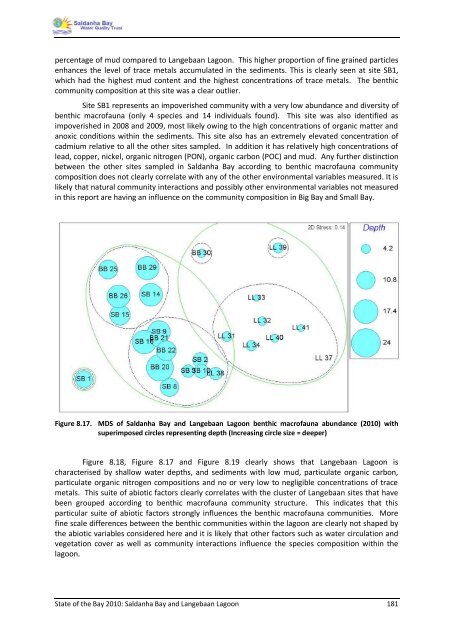State of the Bay Report 2010-Final - Anchor Environmental
State of the Bay Report 2010-Final - Anchor Environmental
State of the Bay Report 2010-Final - Anchor Environmental
You also want an ePaper? Increase the reach of your titles
YUMPU automatically turns print PDFs into web optimized ePapers that Google loves.
percentage <strong>of</strong> mud compared to Langebaan Lagoon. This higher proportion <strong>of</strong> fine grained particles<br />
enhances <strong>the</strong> level <strong>of</strong> trace metals accumulated in <strong>the</strong> sediments. This is clearly seen at site SB1,<br />
which had <strong>the</strong> highest mud content and <strong>the</strong> highest concentrations <strong>of</strong> trace metals. The benthic<br />
community composition at this site was a clear outlier.<br />
Site SB1 represents an impoverished community with a very low abundance and diversity <strong>of</strong><br />
benthic macr<strong>of</strong>auna (only 4 species and 14 individuals found). This site was also identified as<br />
impoverished in 2008 and 2009, most likely owing to <strong>the</strong> high concentrations <strong>of</strong> organic matter and<br />
anoxic conditions within <strong>the</strong> sediments. This site also has an extremely elevated concentration <strong>of</strong><br />
cadmium relative to all <strong>the</strong> o<strong>the</strong>r sites sampled. In addition it has relatively high concentrations <strong>of</strong><br />
lead, copper, nickel, organic nitrogen (PON), organic carbon (POC) and mud. Any fur<strong>the</strong>r distinction<br />
between <strong>the</strong> o<strong>the</strong>r sites sampled in Saldanha <strong>Bay</strong> according to benthic macr<strong>of</strong>auna community<br />
composition does not clearly correlate with any <strong>of</strong> <strong>the</strong> o<strong>the</strong>r environmental variables measured. It is<br />
likely that natural community interactions and possibly o<strong>the</strong>r environmental variables not measured<br />
in this report are having an influence on <strong>the</strong> community composition in Big <strong>Bay</strong> and Small <strong>Bay</strong>.<br />
Figure 8.17. MDS <strong>of</strong> Saldanha <strong>Bay</strong> and Langebaan Lagoon benthic macr<strong>of</strong>auna abundance (<strong>2010</strong>) with<br />
superimposed circles representing depth (Increasing circle size = deeper)<br />
Figure 8.18, Figure 8.17 and Figure 8.19 clearly shows that Langebaan Lagoon is<br />
characterised by shallow water depths, and sediments with low mud, particulate organic carbon,<br />
particulate organic nitrogen compositions and no or very low to negligible concentrations <strong>of</strong> trace<br />
metals. This suite <strong>of</strong> abiotic factors clearly correlates with <strong>the</strong> cluster <strong>of</strong> Langebaan sites that have<br />
been grouped according to benthic macr<strong>of</strong>auna community structure. This indicates that this<br />
particular suite <strong>of</strong> abiotic factors strongly influences <strong>the</strong> benthic macr<strong>of</strong>auna communities. More<br />
fine scale differences between <strong>the</strong> benthic communities within <strong>the</strong> lagoon are clearly not shaped by<br />
<strong>the</strong> abiotic variables considered here and it is likely that o<strong>the</strong>r factors such as water circulation and<br />
vegetation cover as well as community interactions influence <strong>the</strong> species composition within <strong>the</strong><br />
lagoon.<br />
<strong>State</strong> <strong>of</strong> <strong>the</strong> <strong>Bay</strong> <strong>2010</strong>: Saldanha <strong>Bay</strong> and Langebaan Lagoon 181

















